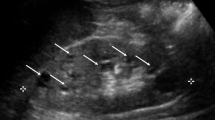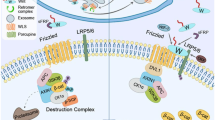Abstract
Pharmacologic inhibition of the renin-angiotensin system (RAS) is a widely accepted and effective treatment for hypertension. However, in the past several years, much attention has been focused on additional roles of the RAS including the possibility that its end-product, angiotensin II, could elicit end-organ pathologies independent of its effect on blood pressure. The ability to selectively delete genes in mice (by homologous recombination or gene knockouts) has led to new — and sometimes surprising — insights into the roles of the RAS in the developmental modeling and pathologic remodeling of the heart and blood vessels.
Similar content being viewed by others
References and Recommended Reading
Gomez RA, Gloor JM: Expression of the renin-angiotensin system in the kidney. In Hypertension: Pathophysiology, Diagnosis, and Management, edn. 2. Edited by Laragh JH, Brenner BM. New York: Raven Press; 1995:1637–1652.
Morishita R, Gibbons GH, Kaneda Y, et al.: Novel and effective gene transfer technique for study of vascular renin angiotensin system. J Clin Invest 1993, 91:2580–2585.
Pratt RE: Regulation of vascular smooth-muscle cell growth by angiotensin II. Blood Press 1996, 2(suppl):6–9.
Schiffrin EL: Correction of remodeling and function of small arteries in human hypertension by cilazapril, an angiotensin I-converting enzyme inhibitor. J Cardiovas Pharmacol 1996, 27(suppl 2):S13-S18.
Schieffer B, Bernstein KE, Marrero MB: The role of tyrosine phosphorylation in angiotensin II mediated intracellular signaling and cell growth [review] [57 refs]. J Mol Med 1996, 74:85–91.
Booz GW, Baker KM: Molecular signalling mechanisms controlling growth and function of cardiac fibroblasts. Cardiovasc Res 1995, 30:537–543.
Hsueh WA, Do YS, Anderson PW, Law RE: Angiotensin II in cell growth and matrix production. Adv Exp Med Biol 1995, 377:217–223.
Yamada T, Horiuchi M, Dzau VJ: Angiotensin II type 2 receptor mediates programmed cell death. Proc Natl Acad Sci U S A 1996, 93:156–160.
Tanimoto K, Sugiyama F, Goto Y, et al.: Angiotensinogendeficient mice with hypotension. J Biol Chem 1994, 269:31334–31337.
Kim HS, Krege JH, Kluckman KD: Genetic control of blood pressure and the angiotensinogen locus. Proc Natl Acad Sci U S A 1995, 92:2735–2739.
Niimura F, Labosky PA, Kakuchi J, et al.: Gene targeting in mice reveals a requirement for angiotensin in the development and maintenance of kidney morphology and growth factor regulation. J Clin Invest 1995, 96:2947–2954.
Kihara M, Umemura S, Sumida Y, et al.: Genetic deficiency of angiotensinogen produces an impaired urine concentrating ability in mice. Kidney Int 1998, 53:548–555.
Kakinuma Y, Hama H, Sugiyama F, et al.: Impaired blood-brain barrier function in angiotensinogen-deficient mice. Nat Med 1998, 4:1078–1080 This is the first report of the fascinating, but little explored role of the RAS in mammals.
Yanai K, Saito T, Kakinuma Y, et al.: Renin-dependent cardiovascular functions and renin-independent bloodbrain barrier functions revealed by renin-deficient mice. J Biol Chem 2000, 275:5–8 This paper makes use of the first reported renin gene knockouts to show that angiotensins in the brain may be generated by enzymes other than renin.
Krege JH, John SW, Langenbach LL, et al.: Male-female differences in fertility and blood pressure in ACE-deficient mice. Nature 1995, 375:146–148.
Carpenter C, Honkanen AA, Mashimo H, et al.: Renal abnormalities in mutant mice. Nature 1996, 380:292–292.
Tsuchida S, Matsusaka T, Chen X, et al.: Murine double nullizygotes of the angiotensin type 1A and 1B receptor genes duplicate severe abnormal phenotypes of angiotensinogen nullizygotes. J Clin Invest 1998, 101:755–760.
Esther CR Jr, Howard TE, Marino EM, et al.: Mice lacking angiotensin-converting enzyme have low blood pressure, renal pathology, and reduced male fertility. Lab Invest 1996, 74:953–965.
Esther CR, Marino EM, Howard TE, et al.: The critical role of tissue angiotensin-converting enzyme as revealed by gene targeting in mice. J Clin Invest 1997, 99:2375–2385 This group used a very clever variation of the gene knockout strategy to test for the relative importance of the membrane-bound and soluble forms of ACE in the mouse.
Hein L, Barsh GS, Pratt RE, et al.: Behavioural and cardiovascular effects of disrupting the angiotensin II type-2 receptor gene in mice. Nature 1995, 377:744–747.
Ichiki T, Labosky PA, Shiota C, et al.: Effects on blood pressure and exploratory behaviour of mice lacking angiotensin II type-2 receptor. Nature 1995, 377:748–750.
Nishimura H, Yerkes E, Hohenfellner K, et al.: Role of the angiotensin type 2 receptor gene in congenital anomalies of the kidney and urinary tract, CAKUT, of mice and men. Mol Cell 1999, 3:1–10.
Nagata M, Tanimoto K, Fukamizu A, et al.: Nephrogenesis and renovascular development in angiotensinogen-deficient mice. Lab Invest 1996, 75:745–753.
Matsusaka T, Nishimura H, Uutsunomiya H, et al.: Chimeric mice carrying ‘regional’ targeted deletion of the angiotensin type 1A receptor gene. Evidence against the role for local angiotensin in the in vivo feedback regulation of renin synthesis in juxtaglomerular cells. J Clin Invest 1996, 98:1867–1877 By taking advantage of the ability to make mice chimeric for inactivation of AT1 receptors, this group was able to study local cellular actions of Ang II on regulating renin secretion from the kidney.
Akishita, M, Horiuchi M, Yamada H, et al.: Inflammation induces vascular remodeling through AT2 receptor expression and signaling. Physiol Genomics 2000, 2:13–20.
Harada K, Komuro I, Shiojima I, et al.: Pressure overload induces cardiac hypertrophy in angiotensin II type 1A receptor knockout mice. Circulation 1998, 97:1952–1959.
Kudoh S, Komuro I, Hiroi Y, et al.: Mechanical stretch induces hypertrophic responses in cardiac myocytes of angiotensin II type 1a receptor knockout mice. J Biol Chem 1998, 273:24037–24043.
Hamawaki M, Coffman TM, Lashus A, et al.: Pressure-overload hypertrophy is unabated in mice devoid of AT1A receptors. Am J Physiol 1998, 274:H868–73.
Matsusaka T, Katori H, Inagami T, Fogo A, Ichikawa I: Communication between myocytes and fibroblasts in cardiac remodeling in angiotensin chimeric mice. J Clin Invest 1999, 103:1451–1458 By taking advantage of the ability to make mice chimeric for inactivation of AT1 receptors, this group was able to study local cellular actions of Ang II on fibroblast proliferation and induction of fibrosis in the heart.
Harada K, Komuro I, Hayashi D, et al.: Angiotensin II type 1a receptor is involved in the occurrence of reperfusion arrhythmias. Circulation 1998, 97:315–317.
Harada K, Sugaya T, Murakami K, et al.: Angiotensin II type 1A receptor knockout mice display less left ventricular remodeling and improved survival after myocardial infarction. Circulation 1999, 100:2093–2099.
Senbonmatsu T, Ichihara S, Price EJ, et al.: Evidence for angiotensin II type 2 receptor-mediated cardiac myocyte enlargement during in vivo pressure overload. J Clin Invest 2000, 106:R25-R29.
Akishita M, Iwai M, Wu L, et al.: Inhibitory effect of angiotensin II type 2 receptor on coronary arterial remodeling after aortic banding in mice. Circulation 2000, 102:1684–1689.
Maeda K, Hata R, Bader M, et al.: Larger anastomoses in angiotensinogen-knockout mice attenuate early metabolic disturbances after middle cerebral artery occlusion. J Cerebral Blood Flow Metab 1999, 19:1092–1098.
Guron G, Friberg P: An intact renin-angiotensin system is a prerequisite for normal renal development. J Hypertens 2000, 18:123–137.
Sugaya T, Nishimatsu S, Tanimoto K, et al.: Angiotensin II type 1a receptor-deficient mice with hypotension and hyperreninemia. J Biol Chem 1995, 270:18719–18722.
Author information
Authors and Affiliations
Rights and permissions
About this article
Cite this article
Methot, D., Reudelhuber, T.L. Knockout of renin-angiotensin system genes: Effects on vascular development. Current Science Inc 3, 68–73 (2001). https://doi.org/10.1007/s11906-001-0083-x
Issue Date:
DOI: https://doi.org/10.1007/s11906-001-0083-x




